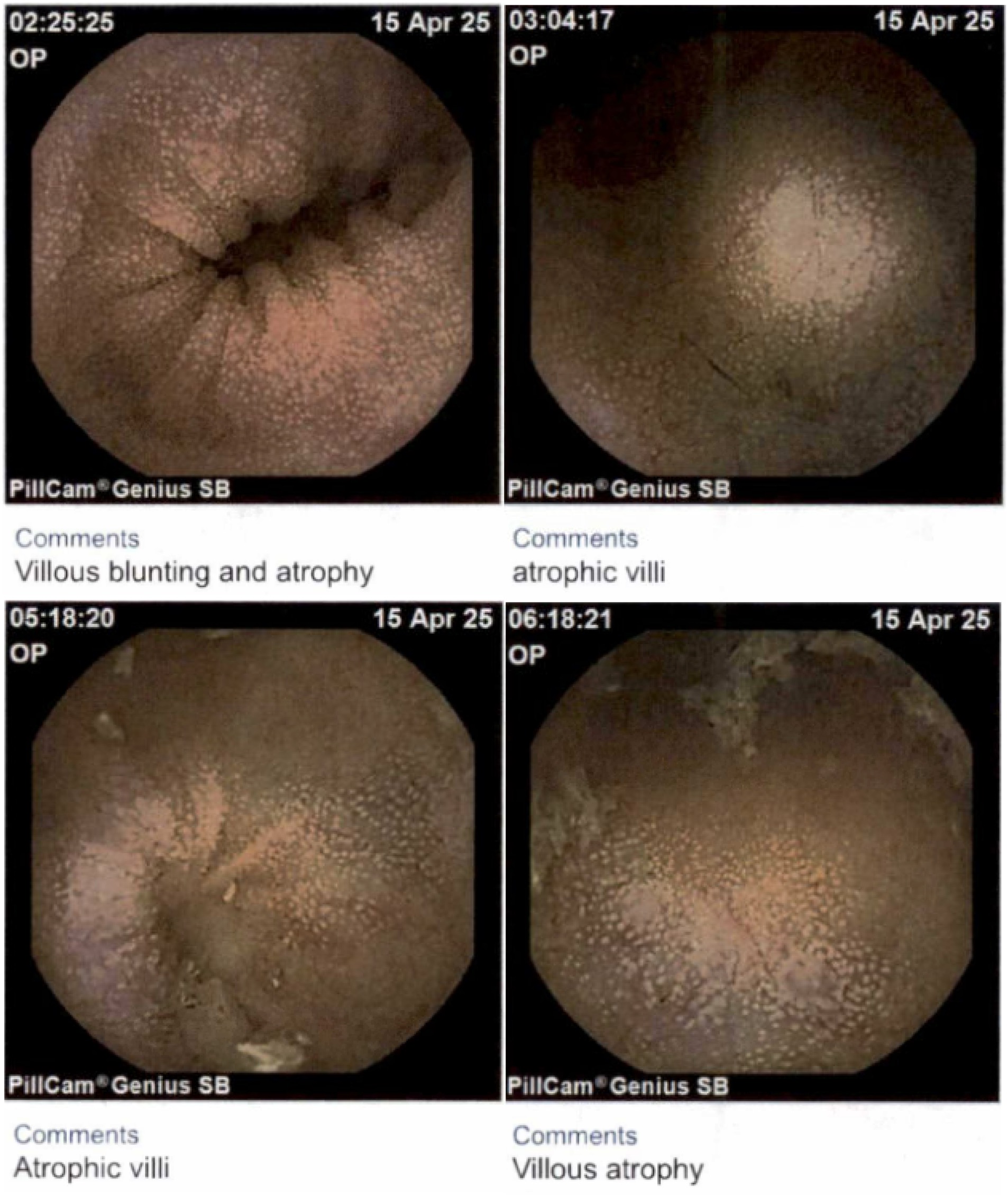Tuesday Poster Session
Category: Small Intestine
P6251 - The Hidden Villain: Chronic Diarrhea and Weight Loss Revealing Olmesartan Enteropathy
Tuesday, October 28, 2025
10:30 AM - 4:00 PM PDT
Location: Exhibit Hall

Gala Godoy Brewer, MD (she/her/hers)
University of Miami Health System
Miami, FL
Presenting Author(s)
Gala Godoy Brewer, MD1, Elaheh Niroomand, MD1, Jodie A. Barkin, MD, FACG2
1University of Miami Health System, Miami, FL; 2University of Miami Miller School of Medicine, Miami, FL
Introduction: Olmesartan is an angiotensin II receptor blocker (ARB) commonly used to manage hypertension. Although generally well-tolerated, a rare but significant adverse effect is sprue-like enteropathy, which can mimic celiac disease both clinically and histologically. We present a case of Olmesartan-induced enteropathy, emphasizing the importance of early recognition to avoid misdiagnosis.
Case Description/
Methods: An 80-year-old female presented with chronic diarrhea, 30-pound weight loss over two months, and elevated fecal calprotectin (FC) following a recent Campylobacter infection and antibiotic treatment for COVID-related complications. Initial labs revealed low fecal elastase, raising suspicion for pancreatic insufficiency. Esophagogastroduodenoscopy (EGD) showed LA Grade A esophagitis and a granular duodenal appearance, though no biopsies were obtained. Stool cultures and panels remained negative on follow-up. A colonoscopy showed normal mucosa; no terminal ileum biopsies were taken. Serologic and histologic evaluation for celiac disease was negative. Empiric trials of pancrelipase, cholestyramine, loperamide, and low-lactose diet failed to alleviate symptoms. A repeat EGD with biopsies and capsule endoscopy demonstrated diffuse villous atrophy, blunting, and granular mucosa from the proximal to distal small bowel. Histopathology revealed villous blunting, increased intraepithelial lymphocytes, foveolar metaplasia, and reactive epithelial changes, findings associated with ARB-induced enteropathy. The patient had been on Olmesartan for several years. Discontinuation of the drug and substitution with an alternative antihypertensive agent led to symptom resolution and normalization of fecal calprotectin.
Discussion: Olmesartan-induced enteropathy is a rare but reversible condition that can closely mimic celiac disease, presenting with chronic diarrhea, weight loss, and villous atrophy. It lacks serologic markers and does not respond to a gluten-free diet. Diagnosis requires a high index of suspicion, especially in patients with negative celiac work-up and persistent gastrointestinal symptoms. Recognition is critical, as prompt discontinuation of the offending agent typically results in rapid clinical improvement and avoids unnecessary diagnostic interventions and treatments. Clinicians should maintain awareness of medication-induced enteropathies, particularly in elderly patients with unexplained malabsorptive symptoms and long-term ARB use. Abstract written with AI corrections.

Figure: Villous atrophy seen during capsule endoscopy
Disclosures:
Gala Godoy Brewer indicated no relevant financial relationships.
Elaheh Niroomand indicated no relevant financial relationships.
Jodie Barkin: AbbVie – Advisor or Review Panel Member. Aimmune Therapeutics – Advisor or Review Panel Member. Amgen – Consultant. CorEvitas – Consultant. Iterative Health – Consultant. Medtronic – Consultant. MotusGI – Consultant.
Gala Godoy Brewer, MD1, Elaheh Niroomand, MD1, Jodie A. Barkin, MD, FACG2. P6251 - The Hidden Villain: Chronic Diarrhea and Weight Loss Revealing Olmesartan Enteropathy, ACG 2025 Annual Scientific Meeting Abstracts. Phoenix, AZ: American College of Gastroenterology.
1University of Miami Health System, Miami, FL; 2University of Miami Miller School of Medicine, Miami, FL
Introduction: Olmesartan is an angiotensin II receptor blocker (ARB) commonly used to manage hypertension. Although generally well-tolerated, a rare but significant adverse effect is sprue-like enteropathy, which can mimic celiac disease both clinically and histologically. We present a case of Olmesartan-induced enteropathy, emphasizing the importance of early recognition to avoid misdiagnosis.
Case Description/
Methods: An 80-year-old female presented with chronic diarrhea, 30-pound weight loss over two months, and elevated fecal calprotectin (FC) following a recent Campylobacter infection and antibiotic treatment for COVID-related complications. Initial labs revealed low fecal elastase, raising suspicion for pancreatic insufficiency. Esophagogastroduodenoscopy (EGD) showed LA Grade A esophagitis and a granular duodenal appearance, though no biopsies were obtained. Stool cultures and panels remained negative on follow-up. A colonoscopy showed normal mucosa; no terminal ileum biopsies were taken. Serologic and histologic evaluation for celiac disease was negative. Empiric trials of pancrelipase, cholestyramine, loperamide, and low-lactose diet failed to alleviate symptoms. A repeat EGD with biopsies and capsule endoscopy demonstrated diffuse villous atrophy, blunting, and granular mucosa from the proximal to distal small bowel. Histopathology revealed villous blunting, increased intraepithelial lymphocytes, foveolar metaplasia, and reactive epithelial changes, findings associated with ARB-induced enteropathy. The patient had been on Olmesartan for several years. Discontinuation of the drug and substitution with an alternative antihypertensive agent led to symptom resolution and normalization of fecal calprotectin.
Discussion: Olmesartan-induced enteropathy is a rare but reversible condition that can closely mimic celiac disease, presenting with chronic diarrhea, weight loss, and villous atrophy. It lacks serologic markers and does not respond to a gluten-free diet. Diagnosis requires a high index of suspicion, especially in patients with negative celiac work-up and persistent gastrointestinal symptoms. Recognition is critical, as prompt discontinuation of the offending agent typically results in rapid clinical improvement and avoids unnecessary diagnostic interventions and treatments. Clinicians should maintain awareness of medication-induced enteropathies, particularly in elderly patients with unexplained malabsorptive symptoms and long-term ARB use. Abstract written with AI corrections.

Figure: Villous atrophy seen during capsule endoscopy
Disclosures:
Gala Godoy Brewer indicated no relevant financial relationships.
Elaheh Niroomand indicated no relevant financial relationships.
Jodie Barkin: AbbVie – Advisor or Review Panel Member. Aimmune Therapeutics – Advisor or Review Panel Member. Amgen – Consultant. CorEvitas – Consultant. Iterative Health – Consultant. Medtronic – Consultant. MotusGI – Consultant.
Gala Godoy Brewer, MD1, Elaheh Niroomand, MD1, Jodie A. Barkin, MD, FACG2. P6251 - The Hidden Villain: Chronic Diarrhea and Weight Loss Revealing Olmesartan Enteropathy, ACG 2025 Annual Scientific Meeting Abstracts. Phoenix, AZ: American College of Gastroenterology.
